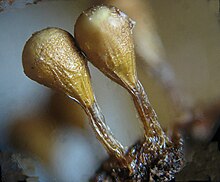Trichia decipiens
| Trichia decipiens | |
|---|---|

| |
| Trichia decipiens plasmodium and sporangia on a tree trunk | |
| Scientific classification | |
| Domain: | Eukaryota |
| Phylum: | Amoebozoa |
| Class: | Myxogastria |
| Order: | Trichiales |
| Family: | Trichiidae
|
| Genus: | Trichia |
| Species: | T. decipiens
|
| Binomial name | |
| Trichia decipiens (
T. Macbr. | |

Trichia decipiens is a worldwide widespread
Trichiida
.
Characteristics
The
fruiting bodies are shiny olive to yellow-olive or brown, and bear mainly stalked, rarely sessile sporangia. These are conical to peak-shaped and are up to 3 mm high and 0.6 to 0.8 (rarely up to 1.3) mm wide.[1]
The shiny, membraneous
calyculus.[1]
The
µm thick elaters, which stand in relief as three to five overhanging spiral strands and become pointed towards the end. The spore mass is olive-yellow to olive, in transmitted light appearing pallidly olive-yellow, occasionally paler. The spores are 10 to 13 µm in diameter, and have a largely reticulated surface, the remainder being densely warty or prickly.[1]
Habitat and ecology
The species has a worldwide distribution.broadleaf trees year-round. The slime mould is associated with, among others, species of the genera Trichia, Arcyria and Cribraria as well as Lycogala epidendrum and Stemonitis typhina.[2]
Classification
Trichia decipiens was first described as Arcyria decipiens in 1795 by Christiaan Hendrik Persoon on the basis of a 1778 collection from a forest in Chemnitz. Macbride reclassified the species in 1899 into the genus Trichia.[1]
